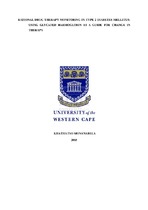| dc.description.abstract | Type 2 diabetes mellitus is a progressive disease characterised by defects in insulin secretion, insulin action or both. Proper management of diabetes with appropriate drug and lifestyle interventions, guided by proper glycaemic monitoring has shown improved glycaemic control and a substantial decrease in morbidity associated with complications and mortality. Evidence-based guidelines for the appropriate management of diabetes, suggests the use of glycated haemoglobin (HbA1c) and fasting plasma glucose (FPG) as monitoring indicators and have set targets levels that indicate appropriate glucose control. In the event of suboptimal control, actions steps to adjust pharmacotherapeutic treatment has been set out. Of the two aforementioned glycaemic monitoring indicators, HbA1c is termed the 'gold standard' as it provides the most comprehensive data i.e. it reflects both fasting and postprandial glucose concentrations over a 3 months period as compared to FPG which only show glucose levels for a few hours. The aim of this study was to describe the use of glycaemic monitoring indicators in patients with type 2 diabetes mellitus, classified as stable, treated at primary health care facilities in the Cape Town Metropolitan Region in South Africa. The study was a descriptive, retrospective and quantitative in design. Data were collected from patient medical records and included glycaemic monitoring tests and results as well as prescribing records for a maximum period of 18 months. The study comprised of 575 participants from five primary health care facilities in the Western Cape Metropole region. All participants had FPG results, while HbA1c results were recorded for 86% of participants at least once. More than 70% of participants with either a FPG or HbA1c result showed suboptimal glucose control i.e. were outside of the target range. In 181 opportunities for intervention in participants with HbA1c results outside target, 113 (62.4%) did not have any therapy adjustments, 19 (10.5%) had the total daily dose increased, 6 (3.3%) had total daily dose decreased, 9 (5.0%) had a step-up in regimen, 5 (2.8%) had a step down in regimen and 29 (16.0%) had a lateral regimen change. In 852 opportunities for intervention in participants with FPG results outside target, 609 (71.5%) did not have any therapy adjustments, 47 (5.5%) had the total daily dose increased, 18 (2.1%) had the total daily dose decreased, 16 (1.9%) had a step-up in regimen, 15 (1.8%) had a step down in regimen and 147 (17.3%) had a lateral change in regimen. This study has demonstrated that in the primary healthcare facilities investigated, FPG was the most often used gycaemic monitoring indicator, glycaemic monitoring of patients mostly show suboptimal glucose control and that opportunities to optimise pharmacotherapy in diabetes management are mostly missed. | en_US |

